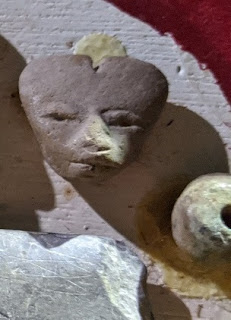Skuguisu káhtqwk (káhtôquwuk)
Pages
Friday, February 28, 2020
An Emerging Serpent (RI)
Monday, February 24, 2020
Ives' Eyes
Search results for that third distinguishing characteristic of a nuchal notch that even a Professional Archaeologist can be trained to identify:
https://wakinguponturtleisland.blogspot.com/search?q=nuchal
Friday, February 21, 2020
Further On Up the Road
Back to that photo from 2016, I observed that this gently undulating row of stones could be said to have been stacked in courses that could be said to resemble smaller stone snakes -rather than stones randomly stacked during field clearing or removal from the road I was walking along or a "formal wall" made using batter boards or strings typical of English stone fence constructions that are more brick or block-like:
What I did not notice until just yesterday was that there may be another snake effigy segment of this row of stones which was in the shadows that day and is just out of the photo:
Thursday, February 20, 2020
Anthropomorphic Effigy faces (Maryland)
I have a collection of artifacts found from 1900-1930 off a farm in Maryland including little faces. The faces look like individuals and are small and flat… I believe they are clay, but not sure..."

Tuesday, February 18, 2020
Are Their (sic) Pre-Colonial Stone Ruins? (Madison CT)
"Those who know say the Uktena is a great snake, as large around as a tree trunk, with horns on its head, and a bright blazing crest like a diamond on its forehead, and scales glowing like sparks of fire. It has rings or spots of color along its whole length, and can not be wounded except by shooting in the seventh spot from the head, because under this spot are its heart and its life. The blazing diamond is called Ulun'suti—"Transparent"—and he who can win it may become the greatest wonder worker of the tribe. But it is worth a man's life to attempt it, for whoever is seen by the Uktena is so dazed by the bright light that he runs toward the snake instead of trying to escape. As if this were not enough, the breath of the Uktena is so pestilential, that no living creature can survive should they inhale the tiniest bit of the foul air expelled by the Uktena. Even to see the Uktena asleep is death, not to the hunter himself, but to his family." - James Mooney Myths of the Cherokee
Follow this link to "Thorson’s Keynote Speech to (sic) NERA:" https://stonewall.uconn.edu/.../thorsons-keynote-speech.../





































